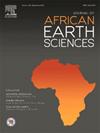Quantifying dynamic source and ground motion parameters for earthquakes bigger than 3.0 in Aswan region, southern Egypt
IF 2.2
4区 地球科学
Q2 GEOSCIENCES, MULTIDISCIPLINARY
引用次数: 0
Abstract
The dynamic source parameters of earthquakes with local magnitudes 3.0, recorded by the Aswan seismic broadband network between 2010 and 2024 in the Aswan region of southern Egypt, have been estimated. A spectral inversion method was applied to separate the source, receiver, and path effects from the observed displacement spectra using linear least squares analysis with a reference site. Initially, the attenuation effects along the ray path and site-specific effects were removed to derive the source spectra for each event. The Brune model was then employed to estimate the dynamic source parameters and their scaling relationships using S-wave displacement source spectra. From the derived displacement spectra, we estimated source parameters for each event, including seismic moment, corner frequency, fault radius, and static stress drop. The results indicate that both stress drop and source radius increase with moment magnitude. The observed stress drops for the studied earthquakes range from 0.4 to 4.8 MPa, suggesting that reservoir-triggered earthquakes may exhibit lower stress drops compared to tectonic or crustal earthquakes. The source radius varies from 139.8 to 294.5 m, while the corner frequency decreases with increasing moment magnitude, ranging from 4.3 to 9.0 Hz. To assess earthquake hazards in the Aswan seismic zone and its surrounding areas, stochastic simulation analyses were conducted for earthquakes with local magnitudes ≥ 3.5 at four sites: New Aswan City, Aswan University, Sahary City, and Kurkur Village. The modeled parameters include peak ground acceleration (PGA), peak ground velocity (PGV), peak ground displacement (PGD), and pseudo-spectral acceleration (PSA). The results revealed that the highest PGA (24.2 cm/s2), PGV (0.4 cm/s), and PGD (0.013 cm) were simulated at Aswan University for the earthquake on November 7, 2010, with an epicentral distance of 2 km. Additionally, the highest PSA values were 72.6 cm/s2 and 65.9 cm/s2 at Aswan University and Sahary City, respectively, for the same event. These findings provide essential insights for evaluating seismic hazards in the Aswan region, contributing to a better understanding of earthquake risks in southern Egypt.
求助全文
约1分钟内获得全文
求助全文
来源期刊

Journal of African Earth Sciences
地学-地球科学综合
CiteScore
4.70
自引率
4.30%
发文量
240
审稿时长
12 months
期刊介绍:
The Journal of African Earth Sciences sees itself as the prime geological journal for all aspects of the Earth Sciences about the African plate. Papers dealing with peripheral areas are welcome if they demonstrate a tight link with Africa.
The Journal publishes high quality, peer-reviewed scientific papers. It is devoted primarily to research papers but short communications relating to new developments of broad interest, reviews and book reviews will also be considered. Papers must have international appeal and should present work of more regional than local significance and dealing with well identified and justified scientific questions. Specialised technical papers, analytical or exploration reports must be avoided. Papers on applied geology should preferably be linked to such core disciplines and must be addressed to a more general geoscientific audience.
 求助内容:
求助内容: 应助结果提醒方式:
应助结果提醒方式:


